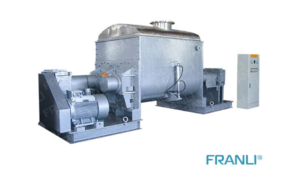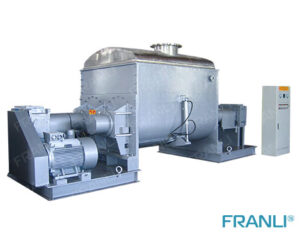Home » How To Use Z Blade Mixer?
How To Use Z Blade Mixer?
Z Blade Mixer
Details of Z Blade Mixer
- low grinding fineness
- Wide range of applications
- high working efficiency
Application: Paint, Adhesive, Battery, Pharmaceutical industry, Cosmetic
There are several parameters that belong in the agitations that can be altered easily along with tweaking over the optimization of the processes here. For instance, the agitator here would be available in their various blade designs along with the angles and the spans with the addition of the number as well as the locations of the tiers along with the operating speed where you would be starting to check out the number of variables that are there to be adjusted in terms of improving the performance over the set of operations. We should also not be forgetting about the baffles here. There are different sets of designs along with the sizes with their additional set of choices involving the manner in which they can be used and the place they can be installed in terms of playing a significant role in terms of improving these processes with the help of the Z blade mixer. So, how would the components be fitting here together for every set of unique applications that are similar in terms of placing together the right pieces of an intricate and one-of-a-kind puzzle here?
We would not be able to resolve the mixing issues of one, but we are trying to offer a few of the specific tips that are involved in mixing. There would be a few agitation processes out there forming the best practices that can make sure of the maintenance of the safety of the processes to help one benefit out of the mixing system that is improved here with the use of the z arm mixer.
Operations of the Z blade mixer
The mixer should never be allowed to operate at a higher speed with the level of the liquid belonging to the level of the blade of the Z mixer. The flow of the fluid here can operate with the fluid present in the vessel at the approx level of the blades with the flow that can cause the skating of the shaft that would be resulting in excessive stress along with the run out over the seal area along with the upper case of this mixer here. It would thereby cause the failure of the seal prematurely and with the damage done on the glass of the Z blade mixer. Making sure that there is the right volume of the product present in the vessel before you turn the mixer on is one simple fix to take care of. It is, therefore, the time to check into the different sets of the sized reactors that can help meet the needs of your processes if it turns out to be a regular issue.
At times there would be misconceptions in terms of operating the mixing systems while the filling is in. It is specifically fine to get started with the operation of the sigma mixer extruder while filling so that it is done quickly with the liquid level that is not being held at the level of the blade. While the liquid is being added, this mixer runs slowly with the speed that should be increased with the increase in the levels. Down pumping is also required here, with the rotation of the impeller allowing the blade to push off the liquid in the downward direction.
Operation of Z blade mixer with the respected solids
While the solid is not present within your vessel, you need to be sure of adding them at least once the level of liquid is above the level of the blade of the laboratory Z blade mixer. The mixer should therefore be operating at slower speeds if it is possible here.
Before this z blade mixer starts, you need to make sure that the agitator here is not being buried within the solids. This should not be started under the right set of circumstances. Instead, the filling should be about 8 to 10″ above the level of the blade for the kneader extruder here.
There would be situations that can take place where the solids are being packed above the level of the mixer with them being started to be done in a slower manner and should be handled under great care. The liquid should then be added for dissolving the solid before they even try it sooner if the Z blade mixer fails to start.
Viscosity and the Boil-off
The term referring to the ambient input of heat that is being used for the removal of the impurities through the process here is the boil off. This mixer here should not be operating at complete speed, mainly if the product witnesses an increase in its viscosities during the boil-off. The mixer here should slow down to at least half of the required speed if the sigma kneader is to operate during the process needed for boil off.
The Z blade mixers have their innovative design derived through the other variants of the mixers. This paddle here offers a similar performance in mixing as that of the others here that consumes less power as offered through manufacturers like Franli. The mixing element here wears off and is less than that of the plows. It is due to the mixing of the elements during agitation and dispersion that is made of while dealing with the viscous or the sticky materials.
The Z blade mixer is considered to be the superior as they have the ability to mix the materials in a greater aggressive manner along with keeping the similar kind of power consumption brought about mainly due to the fact of its unique designed paddles that consists of the highly patched ribbon sizes to help move a greater amount of materials all within a single turning here.
Welcome to send inquiry to us and let’s make a win win business together !
Guidelines For Kneader
The dispersion kneader is suited for rubber and plastic mastication, as well as the blending of different rubber and plastic components. Small and medium-sized rubber and plastics manufacturers with a wide range of product types and colours, as well as food, dyes, pharmaceuticals, and ceramics, can benefit from the internal mixer.

Sigma Kneader: The Solution for Mixing and Kneading
Sigma kneader is a versatile machine that can be used for mixing, kneading, and homogenizing a wide range of materials, including high-viscosity products.

Sigma Mixer: Indispensable Equipment For Manufacturing
Sigma Mixer is a type of mixer that uses a unique mixing principle to achieve an efficient blending of materials. The mixer consists of two blades that rotate in opposite directions, creating a kneading and folding action that ensures thorough mixing. The blades are shaped like the Greek letter Sigma, hence the name Sigma Mixer.

Sigma Blade Mixer: The Mixing Solution
The Sigma Blade Mixer is a robust and reliable mixing machine that uses a unique mixing principle to achieve superior results. It is a type of double-arm kneading mixer that features two blades that rotate in opposite directions.

Vacuum Kneader: A Machine for Your Mixing Needs
The Vacuum Kneader is a type of mixer that utilizes a vacuum chamber to create a homogeneous mix of ingredients. It is designed to knead, mix, and disperse high-viscosity materials under vacuum conditions, resulting in a superior product.

Efficiency and Effectiveness of Dispersion Kneader
The dispersion kneader has complete control over the mixing and blending of the raw materials to create an even mix that allows for better distribution. This device contains a mixing chamber with rotating blades made of high-quality steel.

Vacuum kneader: high efficiency and environmental protection
A vacuum kneader is mainly used for stirring, mixing, and kneading high-viscosity and elastic-plastic materials. The most common fields include high-viscosity sealant, silicone rubber, neutral acid glass glue, chewing gum, bubble gum, aluminum silver paste, silica gel, paper pulp, cellulose, and other materials. It covers food, agrochemical, pharmaceutical, cosmetics, electronic paste, and other industries, and has been sought after by the industry.

